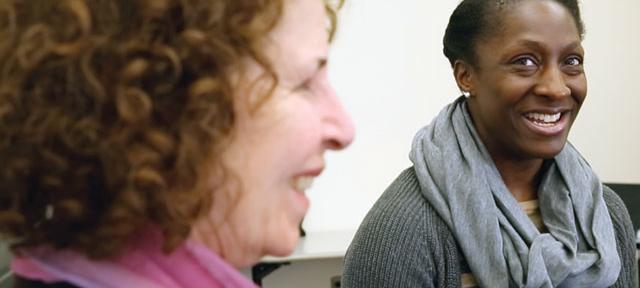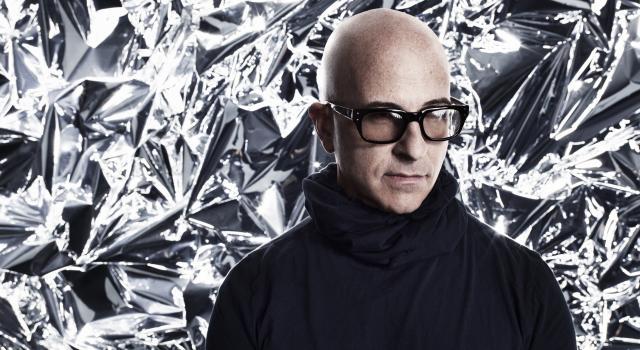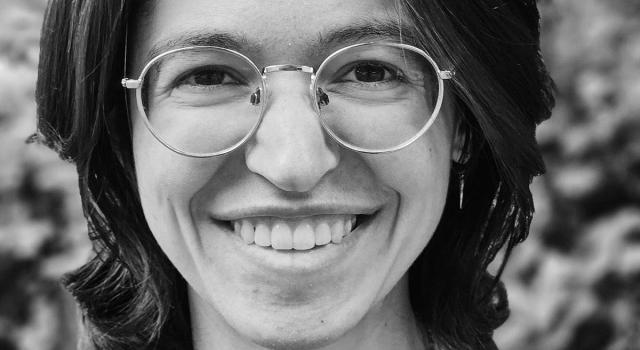Setbacks, Outtakes, and a Little Gem of Hampshire-ness

This is the first in a series of conversations between faculty members, one who has decades of experience at Hampshire and the other fairly new to the College. Becky Nordstrom and Deborah Goffe spoke together last spring, with a camera rolling, at the Music and Dance Building. Becky is professor emerita of dance, recently retired from Hampshire; former member of Laura Dean Dancers and Musicians in New York City; and the cofounder of Collaboration Danceworks of Vermont. Deborah is assistant professor of modern and contemporary dance; founder of Scapegoat Garden, a Hartford-based collaborative dance theater company; and former dance coordinator at Charter Oak Cultural Center.
(Reprinted from the Summer 2016 issue of Hampshire's Non Satis Scire Magazine.)
Videographer: This is just for sound check. Can I ask each of you, one at a time, to count to five?
Deborah: Sure. 1, 2, 3, 4, 5.
Becky: 1, 2, 3, 4, 5.
Videographer: Thank you.
Becky: We’re already choreographing.
Becky: How are you surviving? This time of the semester can be intense.
Deborah: I feel like I’m finding my stride, actually. The start of the semester was full and a little confusing since it was my first, unfiltered experience with Hampshire. Daphne had been so nurturing, and in a way I saw things through her eyes, which had been a comfort. Then, suddenly, it was, Oh, I’m out here alone. What does this look like to me? What do I think about it?
Becky: Took off the training wheels.
Deborah: Absolutely. They were off and we were moving. By this point in the semester I understand the rhythm better. I also have a stronger sense of what I care about in this context. It feels a little more like my place. But I have to tell you that Aliza, our intern, and I have been joking about What Would Daphne Do? What Would Becky Do? We need bracelets.
Becky: There’s always improvisation, which is part of what we do in our field anyway. But watching you last year when we overlapped, you were a quick study. One of the things you brought here, in addition to your experience and background, is an aesthetic vision. I’ve seen you bring that to your teaching, in how you talk with students about their creative process. The way we work with students here, and mentor them, the model is not so much critique — let’s see what’s wrong with this picture — but more of a conversation, an engagement, trying to help them articulate and embody the ideas they have more fully. Often their interests aren’t just with dance, but dance in relationship to neuroscience or social justice . . . different combinations. It presents an interesting challenge for us. It means that as we’re helping them shape their questions, we’re learning right along
with them.
Deborah: I won’t forget the first moment I really understood that Hampshire is its own place entirely. I was meeting with a student and she was talking about her Div III plans in a way that was so self-possessed and so clear. But the topic was something I’d never heard of in my entire life. In that moment I felt absolute intimidation — and excitement. How does one work with this? The blurring of the line between student and colleague, and the way it happens so early for these undergrads, is magical. After I had been in the trenches and saw how it all unfolds over time, I moved from simply engaging with students and their ideas to really advocating for them.
Becky: That’s where the nudging comes in, right? You help bring them to a new place.
Deborah: Absolutely. Make it manifest. Nurture and be supportive, but challenge them to dig deeper. And the intimidation part goes away.
Deborah: I have a question for you. Maybe this is common to Hampshire people. You had a rich artistic practice. I’m curious how you managed to balance that in a place like Hampshire, or does it get nurtured in a place like this?
Becky: It’s tricky. Part of what helped me was having a creative partner, Billbob Brown at UMass, who egged me on. When I felt I just didn’t have the time to do my creative work, he would insist. He’d say, “We’ve got a date. We’re going to do this piece at such-and-such a time, and we have to make it work.” If he hadn’t been doing that, I would have let more go. I would have let myself get subsumed under the weight of the academic workload. It’s a challenge. I have concerns about that for you. I want you to have your full, rich, creative life — because that’s what nurtures us and feeds our teaching. If you’re not juiced with your own work, the teaching becomes less juicy, too.
Deborah: Yes, it’s quite a gift for students to see creative engagement modeled for them. But there are ways that dance can evaporate over time. Things happen to the body and things happen in life that can be a barrier to continuing. In some of the videos I’ve watched of you and Billbob, the really exciting thing, to me, is seeing how you reinvent. The span and the evolution in your work, both solo and together — it’s inspiring. I imagine it’s inspiring for your students to witness that, too, to imagine a life in art and not just a moment.
Becky: Exactly.
Deborah: So you got a push from having a partner. How did you manage in the absence of that? I ask because I’m doing solo work right now.
Becky: Well, I really loved performing. I loved it more than choreographing. I found if I wanted to perform, I had to make work, and it was easier in some ways to make work on myself, for myself, because I could fit in rehearsal time around the other things I was doing. Also, I had an early sabbatical some years ago and did a solo concert. I spent the time going around the country and having colleagues and friends of mine from various walks of life either make work for me, or restage a solo of their own on me. That’s how I ended up doing a full solo concert. It was a wonderful way to engage with other artists, try to get inside their skin. It stretched me as a performer.
Deborah: There’s pragmatism in solo work, too. Logistically, it’s practical and economical.
Becky: Yes, that’s the other part of it.
Deborah: Then there’s the thrill that can come from working with other people, the spark that can happen when you’re in a room together. You have an idea, and it’s a little lame, but through the togetherness it turns into something you couldn’t have imagined. I’m a little addicted to that. There’s a kind of relinquishing that happens, too. I’m not somebody who’s going to cast pieces on bodies that move like mine and look like mine and have a similar kinesthetic impulse. So there’s compromising, is one way to think about it. Right now I’m asking myself what actually lives here, what’s actually in me. If I don’t have to negotiate it in another body or, as you described it, stretching into another’s skin, which is a really beautiful picture — what does that look like? How is that different from what it had been a while ago? These are vessels that are ever changing.
Becky: And how can that be perceived by an audience? How do you create a character or a place or an idea that resonates with an audience? One of my concerns is how to work with dance in a humanistic way. It’s not about technique. I mean, there’s technique under there, and that’s important. But what humanizes it? What makes people engage and somehow empathize with whatever character I’m portraying?
Deborah: That makes me think of another question. It’s a big question, actually.
Becky: Oh, good.
Deborah: What will break through that barrier that people have around dance? We all have bodies, they’re all expressive, and yet dance can be off-putting. I’m really curious about the ways that can be bridged, and what the implications are for people who want to go into the field. That’s always been a challenge for me.
Becky: Actually, one thing I’ve seen you do so beautifully, and that really helps in this area, are the talk-backs after your performances. You’re brilliant at it, having a conversation with the audience, the opportunity for them to ask questions and for you as a choreographer or for the dancers to talk about the experience. It demystifies it. In the conversation, audience members start to realize that they have ideas about what they saw. Often, they just don’t think their ideas are legitimate because they didn’t have a frame of reference.
Deborah: There must be some secret language for it . . .
Becky: Yes, the secret language. You see people light up as they talk about what they saw and what they understand. The performance becomes not only an artistic enterprise, but also an educational one.
Deborah: I was in an advising meeting recently with a student who was grappling with the challenge of creating space for people to claim their body’s expressive capacity. She’s interested how it might put people in communication with their emotional capacity, as well. She created an evening around a piece that she had choreographed, and was going to perform it in a fairly traditional way, like a Div III concert. But before the performance, she pulled back. I was like, Really? I wasn’t sure if she was motivated by fear or was thinking that the format really wouldn’t serve her purpose. Maybe it was a little of both.
The event turned into sort of a workshop, where she guided the guests through a process that made it possible for them to receive that one little morsel which was her performance. She had been concerned that the audience wouldn’t be prepared, that they’d show up with the fear we talked about earlier, and might miss what she was trying to communicate. So she built a series of engagements over two and a half hours that were so playful and warm and rooted in a lovingness that by the time she got to the piece itself, everybody was ready for it. They were kind of beyond ready for it.
For me, it was an amazing experience to see a student be that clear about how she needed her work to be received, to think through how it could best happen, and then do it expertly. Then she processed it afterward, and considered ways that the performance context might shift in her hands in the future. I’ve learned that Hampshire makes that
kind of play possible. She was able to think quite big, change her mind and scale back, and then let it grow in the new place.
That there’s room for all that experiencing was challenging for me. To trust that her work would turn into something fruitful, and to witness that fruitfulness, for me it was a huge education. It felt particular to a Hampshire education that something like that could happen in a year. It seems like it would normally happen over ten years of working at it.
Becky: Or over a career.
Deborah: Absolutely. That to me feels like a little gem of Hampshire-ness.
Becky: This happens again and again with Hampshire students because often their ideas or interests are coming from a very particular place, a particular question, a particular interest, or sometimes a particular fear. When we’re working with students, we’re not just thinking about the final product, what it’s going to look like in the end. It’s really about the journey, the process, the growth and the changes. It’s about the setbacks, the outtakes, what you throw on the cutting-room floor. And some of those snippets you throw out in a given project aren’t really gone.
Deborah: There can be good stuff in there.
Becky: They live somewhere. Often when we throw something out we say it’s a great idea but it just doesn’t belong here. It’s something that needs to grow on its own somewhere else. That traveling through all the stages can be difficult and sometimes painful for students. But it’s an important part of the process.
Deborah: I’ve been thinking that we act as a kind of midwife.
Becky: We make the call about whether this is the moment to push, or to nurture and nudge, or to embrace and support. Or just wait. Another big, big idea in working with Hampshire students is learning to listen. The impulse will be to jump in and try to fix, to help them do it. But to be able to sit back and be patient . . .
Becky: I had a student who was a terrific choreographer and dancer and mover. She was interested in teaching children, so she went on to graduate school, to Harvard, to study dance education, movement education, multi-arts education. She moved back to the tiny town in Vermont where she’d grown up, went into the schools, and started creating dance programs. She came back to Amherst and talked about her work, about the kids, the poverty, and she was quite upbeat about what she was doing. She could have done anything. She could have been a dancer in New York. But this was her calling. That inspires me.
Deborah: It makes me think of a course I’m teaching now. We’re having conversations about place. I’ve asked my students to research a place they might call theirs, whether it’s somewhere they’ve lived or would like to live, and to pull information about the creative resources that exist there. What’s the ecology of the arts community there? The project has started wonderful conversations about who gets to have art, and students are starting to build projects that fill a gap. You just mentioned New York. In my mind, New York has plenty. But if we really think dance has power, where are the other places that can be served by that power of the body? Among the students in this class are dancers, a theater person, a visual artist, a glassblower, and a musician.
Becky: I like that, glassblower.
Deborah: They’re discovering realities about the way arts infrastructure has worked. To see them start to have a love for place in a way that’s nurturing, where they’re gathering resources and knowledge with the intent to give it away -— I’m really partial to that.
Reprinted from the Summer 2016 issue of Hampshire's Non Satis Scire magazine.



